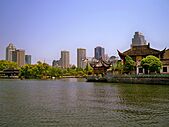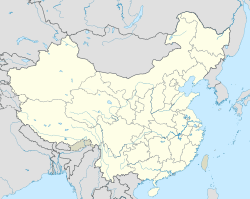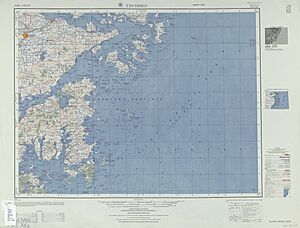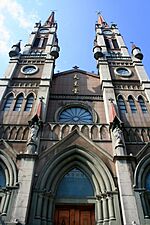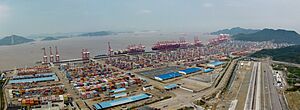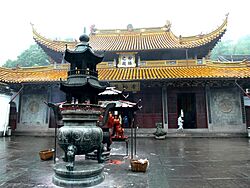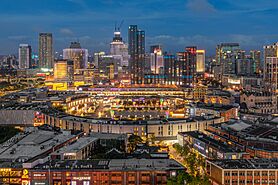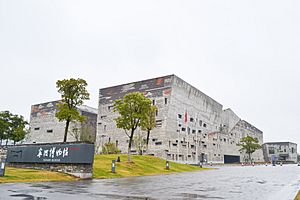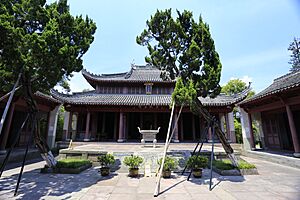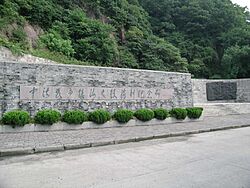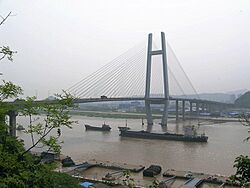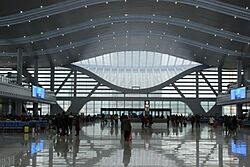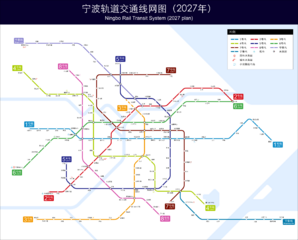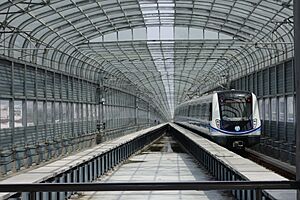Ningbo facts for kids
Quick facts for kids
Ningbo
宁波市
Ningpo
|
|
|---|---|
|
Prefecture-level and sub-provincial city
|
|
|
Clockwise: Ningbo city god temple, Yinzhou District Government of Ningbo, Tianfeng Pagoda, Dongqian Lake, Tianyi Pavilion Museum
|
|
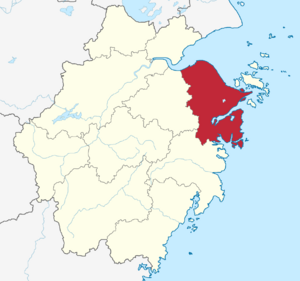
Ningbo City in Zhejiang
|
|
| Country | China |
| Province | Zhejiang |
| County-level divisions | 11 |
| Township divisions | 148 |
| Municipal seat | Yinzhou District |
| Government | |
| • Type | Sub-provincial city |
| • Body | Ningbo Municipal People's Congress |
| Area | |
| • Prefecture-level and sub-provincial city | 9,816.23 km2 (3,790.07 sq mi) |
| • Urban | 2,461.8 km2 (950.5 sq mi) |
| • Metro | 2,461.8 km2 (950.5 sq mi) |
| Elevation | 150 m (488 ft) |
| Population
(2022 census)
|
|
| • Prefecture-level and sub-provincial city | 9,618,000 |
| • Density | 979.81/km2 (2,537.69/sq mi) |
| • Urban | 7,585,000 |
| • Urban density | 3,081.08/km2 (7,980.0/sq mi) |
| • Metro | 2,033,000 |
| • Metro density | 825.82/km2 (2,138.9/sq mi) |
| GDP | |
| • Prefecture-level & Sub-provincial city | CN¥ 1.570 trillion US$ 233.5 billion |
| • Per capita | CN¥ 163,911 US$ 24,369 |
| Time zone | UTC+8 (China Standard) |
| Postal code |
315000
|
| Area code(s) | 574 |
| ISO 3166 code | CN-ZJ-02 |
| Vehicle registration | 浙B |
| City trees | Camphor Laurel Cinnamomum camphora (L.) Sieb. |
| City flowers | Camellia |
| Ningbo | |||||||||||||||||||||||||||||||||
|---|---|---|---|---|---|---|---|---|---|---|---|---|---|---|---|---|---|---|---|---|---|---|---|---|---|---|---|---|---|---|---|---|---|

"Ningbo" in Simplified (top) and Traditional (bottom) Chinese characters
|
|||||||||||||||||||||||||||||||||
| Simplified Chinese | 宁波 | ||||||||||||||||||||||||||||||||
| Traditional Chinese | 寧波 / 𡩋波 | ||||||||||||||||||||||||||||||||
| Wu | (locally) | ||||||||||||||||||||||||||||||||
| Literal meaning | "Tranquil Waves" | ||||||||||||||||||||||||||||||||
|
|||||||||||||||||||||||||||||||||
Ningbo{{efn|Chinese: 宁波; pinyin: Níngbō; Ningbo dialect: gnin² poq⁷ IPA: [ɲìɲ.póʔ], Standard Mandarin pronunciation: [nǐŋ pu̯ó]), also called Ningpo, is a big city in eastern China. It's located in the Zhejiang province, near the East China Sea. Ningbo is a very important port city and a major economic hub in the Yangtze Delta region.
The port of Ningbo–Zhoushan is one of the busiest ports in the world. It handles a huge amount of cargo and containers every year. Ningbo is also known for its long history and rich culture. It's considered one of the oldest cities in China, with roots going back thousands of years.
Contents
- What's in a Name?
- A Glimpse into History
- Where is Ningbo?
- Ningbo's Weather
- How Ningbo is Governed
- Ningbo's Economy
- Ningbo Port: A Global Giant
- Fun Places to Visit
- Famous People from Ningbo
- Getting Around Ningbo
- Ningbo's Language
- Delicious Food
- Education in Ningbo
- Sister Cities
- Images for kids
- See also
What's in a Name?
The name Ningbo means "serene waves." The first part, ning, means "serene" or "peaceful." The second part, bo, means "wave."
The city is also called "Yong" for short. This comes from "Yong Hill," a coastal hill nearby, and the "Yong River" that flows through the city.
Long ago, Ningbo was known as Mingzhou. This name came from two lakes inside the old city walls: the Sun Lake and the Moon Lake. The Sun Lake disappeared in the 1800s but was brought back in 2002.
A Glimpse into History
Ningbo is one of China's oldest cities. Its history goes back to cultures like the Jingtou Mountain Culture (around 6300 BC) and the Hemudu culture (around 4800 BC). This shows that people lived here a very long time ago.
Ningbo was an important trading city on the ancient Silk Road. It became a major port for trade with other countries.
Early History
The earliest signs of people in Ningbo are from the Jingtou Mountain site. These findings show that early humans ate seafood and rice. The Hemudu culture also left behind tools and signs of farming, showing that people settled and built communities here.
Before the Han dynasty, the Ningbo area was not very crowded. Later, during the Spring and Autumn period, a city called Juzhang was built. This was the first city in the Ningbo area.
Trade and Foreign Connections
Since the Tang dynasty, Ningbo has been a key port for business. Arab traders lived in Ningbo during the Song dynasty. They had their own customs and religion. There was also a Jewish community in Ningbo.
In the 1500s, European traders, especially the Portuguese, came to Ningbo. They set up trading posts on nearby islands. However, their activities sometimes included conflicts with local Chinese cities. The Portuguese were asked to leave the Ningbo area in 1548.
Ningbo as a Treaty Port
In 1842, after the First Opium War, Ningbo became one of the first five Chinese "treaty ports." This meant it was opened for trade with Western countries like the United Kingdom. British forces briefly took over Ningbo during the war.
Later, in 1861, forces from the Taiping Kingdom took the city for about six months. In 1885, during the Sino-French War, there were naval battles near Ningbo.
Ningbo was also famous for making traditional Chinese furniture. Western books often described it as a center for skilled craftsmanship.
World War II Impact
During World War II, in 1940, many people left Ningbo. The city was bombed by Japanese forces. There was also an outbreak of a serious disease, the bubonic plague, which caused many deaths.
Where is Ningbo?
Ningbo is on the eastern coast of China. To its east is the East China Sea and the Zhoushan Archipelago. To the north, it faces Jiaxing and Shanghai across Hangzhou Bay. To the west and south, it borders other cities like Shaoxing and Taizhou.
The city has a large land area and an even larger ocean area. It has a very long coastline, with many islands under its control. The Siming Mountains run through parts of Ningbo, with some peaks reaching high elevations.
Ningbo's Weather
Ningbo has four distinct seasons. Summers are hot and humid, while winters are chilly, cloudy, and dry, with occasional snow. The average temperature is about 17.15 degrees Celsius (62.87°F). July is the warmest month, and January is the coldest.
The city gets a lot of rain, especially in June during the "plum rains" season. From August to October, Ningbo can be affected by typhoons, which are strong storms. Because of its coastal location, Ningbo is at risk of flooding due to climate change. The city is working on "sponge city" strategies to help manage heavy rainfall.
| Climate data for Ningbo (Yinzhou District) (1991–2020 normals, Extremes 1951–2013) | |||||||||||||
|---|---|---|---|---|---|---|---|---|---|---|---|---|---|
| Month | Jan | Feb | Mar | Apr | May | Jun | Jul | Aug | Sep | Oct | Nov | Dec | Year |
| Record high °C (°F) | 24.4 (75.9) |
28.9 (84.0) |
34.0 (93.2) |
34.3 (93.7) |
36.3 (97.3) |
38.0 (100.4) |
39.0 (102.2) |
42.1 (107.8) |
38.8 (101.8) |
34.5 (94.1) |
29.5 (85.1) |
25.0 (77.0) |
42.1 (107.8) |
| Mean daily maximum °C (°F) | 9.6 (49.3) |
11.7 (53.1) |
15.8 (60.4) |
21.7 (71.1) |
26.2 (79.2) |
29.0 (84.2) |
33.9 (93.0) |
33.1 (91.6) |
28.8 (83.8) |
24.8 (76.6) |
18.5 (65.3) |
12.4 (54.3) |
22.1 (71.8) |
| Daily mean °C (°F) | 5.8 (42.4) |
7.5 (45.5) |
11.1 (52.0) |
16.5 (61.7) |
21.5 (70.7) |
24.9 (76.8) |
29.1 (84.4) |
28.8 (83.8) |
24.8 (76.6) |
19.7 (67.5) |
14.1 (57.4) |
7.1 (44.8) |
17.6 (63.6) |
| Mean daily minimum °C (°F) | 2.9 (37.2) |
4.3 (39.7) |
7.6 (45.7) |
12.7 (54.9) |
17.8 (64.0) |
21.8 (71.2) |
25.8 (78.4) |
25.7 (78.3) |
21.8 (71.2) |
16.3 (61.3) |
10.8 (51.4) |
4.8 (40.6) |
14.4 (57.8) |
| Record low °C (°F) | −8.8 (16.2) |
−6.2 (20.8) |
−3.7 (25.3) |
0.7 (33.3) |
7.4 (45.3) |
12.7 (54.9) |
18.2 (64.8) |
18.4 (65.1) |
11.0 (51.8) |
1.4 (34.5) |
−3.0 (26.6) |
−8.5 (16.7) |
−8.8 (16.2) |
| Average precipitation mm (inches) | 83.9 (3.30) |
78.6 (3.09) |
125.2 (4.93) |
103.8 (4.09) |
118.2 (4.65) |
233.6 (9.20) |
165.9 (6.53) |
205.7 (8.10) |
176.3 (6.94) |
88.9 (3.50) |
78.7 (3.10) |
69.1 (2.72) |
1,527.9 (60.15) |
| Average precipitation days (≥ 0.1 mm) | 12.3 | 11.6 | 15 | 14 | 13.6 | 16.8 | 12.1 | 15 | 13.5 | 8.9 | 10.6 | 10.5 | 153.9 |
| Average snowy days | 2.5 | 1.9 | 0.6 | 0.1 | 0 | 0 | 0 | 0 | 0 | 0 | 0 | 0.9 | 6 |
| Average relative humidity (%) | 75 | 75 | 74 | 72 | 74 | 81 | 75 | 77 | 78 | 75 | 76 | 74 | 76 |
| Mean monthly sunshine hours | 101.5 | 103.1 | 123.2 | 149.6 | 160.7 | 120.2 | 218.6 | 202.6 | 149 | 153.3 | 112.9 | 113.8 | 1,708.5 |
| Percent possible sunshine | 31 | 33 | 33 | 39 | 38 | 29 | 51 | 50 | 41 | 44 | 36 | 36 | 38 |
| Average ultraviolet index | 4 | 5 | 7 | 9 | 10 | 11 | 11 | 11 | 9 | 7 | 4 | 3 | 8 |
| Source 1: China Meteorological Administration Weather Chinaall-time extreme temperature | |||||||||||||
| Source 2: Weather Atlas (uv) | |||||||||||||
How Ningbo is Governed
Ningbo is a "sub-provincial city." This means it has a lot of power to make its own economic and financial decisions, almost like a province. It's one of only five such cities in China.
The city is led by a Party Secretary, currently Peng Jiaxue. The Mayor of Ningbo, Qiu Dongyao, is the second-in-command.
City Districts and Counties
Ningbo is divided into different areas:
- Six urban districts: Haishu, Yinzhou, Jiangbei, Beilun, Zhenhai, Fenghua.
- Two county-level cities: Yuyao, Cixi.
- Two counties: Xiangshan, Ninghai.
These areas work together to form the larger Ningbo metropolitan area.
| Map | ||||||
|---|---|---|---|---|---|---|
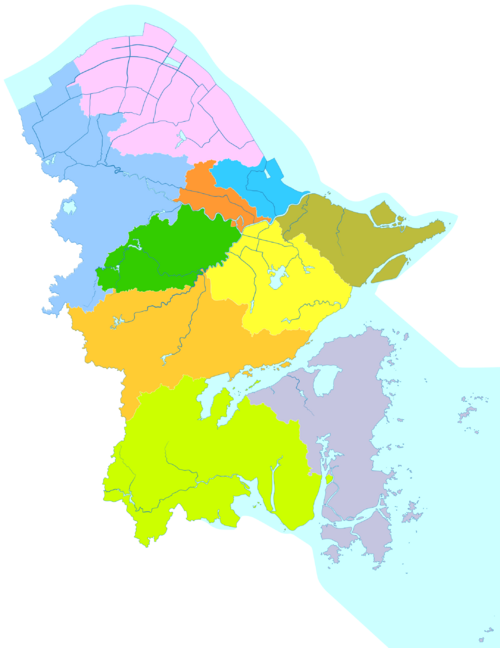
Haishu
Jiangbei
Beilun
Zhenhai
Yinzhou
Fenghua
Xiangshan
County Ninghai
County Cixi
(city) |
||||||
| Subdivision | Simplified Chinese | Pinyin | Population (2022) | Area (km2) | Density | Urbanization Rate(%) |
| 6 Central Urban Districts | ||||||
| Haishu District | 海曙区 | Hǎishǔ Qū | 1,058,000 | 595.03 | 1,748.29 | 88.1 |
| Yinzhou District | 鄞州区 | Yínzhōu Qū | 1,662,000 | 799.09 | 2,079.86 | 83.0 |
| Jiangbei District | 江北区 | Jiangbei Qū | 503,000 | 208.14 | 2,416.64 | 84.7 |
| Beilun District | 北仑区 | Běilún Qū | 879,000 | 597.76 | 1,470.48 | 77.8 |
| Zhenhai District | 镇海区 | Zhènhǎi Qū | 516,000 | 244.28 | 2,112.33 | 91.1 |
| Fenghua District | 奉化区 | Fènghuà Qū | 586,000 | 1,267.60 | 462.29 | 61.2 |
| 2 Southern Counties | ||||||
| Xiangshan County | 象山县 | Xiàngshān Xiàn | 576,000 | 1,382.18 | 416.73 | 62.5 |
| Ninghai County | 宁海县 | Nínghǎi Xiàn | 709,000 | 1,843.26 | 384.64 | 63.7 |
| 2 Northern County-Level Cities | ||||||
| Yuyao | 余姚市 | Yúyáo Shì | 1,264,000 | 1,500.80 | 842.21 | 81.4 |
| Cixi | 慈溪市 | Cíxī Shì | 1,865,000 | 1,360.63 | 1,370.68 | 80.1 |
| Sum | 9,618,000 | 9,816.23 | 979.80 | 78.9 | ||
Ningbo's Economy
Ningbo is a very important city for trade and business. Its history of exporting goods goes back to the 7th century. Today, Ningbo exports many things, like electronics, clothes, food, and industrial tools.
The city's economy is strong, with a lot of growth. In 2022, Ningbo's economy was one of the largest in China. It's also one of the wealthiest cities in China, with high average incomes. Many big companies have their main offices or regional offices in Ningbo.
Special Economic Zones
Ningbo has several special development zones. These areas offer benefits to encourage foreign companies to invest. This has brought many international businesses and people to the city.
- Ningbo Economic & Technological Development Zone (NETD): This zone is near the port and airport. It has grown a lot over 20 years.
- Ningbo National Hi-Tech Industrial Development Zone: This zone focuses on technology and research. It's a key place for new ideas in the Yangtze River Delta.
- Ningbo Free Trade Zone: This is a special area where goods can be traded with fewer taxes and rules. It's the only free trade zone in Zhejiang Province.
Ningbo Port: A Global Giant
The Port of Ningbo–Zhoushan is the busiest port in the world for cargo. It can handle huge ships, even those weighing 300,000 tons. The port is mainly located in the Beilun and Zhenhai districts.
Since 2006, Ningbo Port has been expanding. It's working with the nearby city of Zhoushan to create an even bigger port. This helps it compete with other major ports in the region, like Shanghai. In 2021, the port handled over 1.2 billion tons of cargo!
Ningbo is part of the "21st Century Maritime Silk Road." This is a modern trade route that connects China to countries in Asia, Africa, and Europe by sea.
Fun Places to Visit
Ningbo has many interesting places to visit because of its long history and culture. Here are some of the main attractions:
Haishu District Highlights
- Moon Lake Park: This is a man-made lake dug during the Tang dynasty. It has islands, old buildings, and historical sites.
- Tianyi Pavilion: Built in 1516 AD, this is the oldest library in Asia and one of the oldest private libraries in the world. It holds many old books and records. The area also includes a traditional Chinese garden and a small Mahjong museum.
- Yuehu Mosque (Moon Lake Mosque): A historical mosque built in 1003 AD.
- Drum Tower Complex (Haishu Tower): This is the only remaining part of an old city gate tower from the Tang dynasty. There's a shopping area around it built in a traditional style.
- Chenghuang Temple: An ancient temple of the City God in downtown Ningbo.
- Tianfeng Pagoda: A tall, old tower built in 695 AD during the Tang dynasty. It's a landmark of the city.
- Tianyi Square: A popular shopping area in downtown Ningbo, named after the famous Tianyi Pavilion library.
- Nantang Old Street: A renovated old commercial street with shops and restaurants.
- Liangzhu Cultural Park: A park dedicated to the famous Chinese love story, the Butterfly Lovers.
Yinzhou District Wonders
- Ningbo Museum: A museum about Ningbo's history and customs. It was designed by Wang Shu, a famous Chinese architect.
- Romon U-Park: One of the largest indoor theme parks in the world.
- Dongqian Lake: The biggest natural freshwater lake in Zhejiang Province. You can find temples, islands, and a rock carving park around the lake.
- Qita Temple: A Buddhist temple complex that started in the Tang dynasty.
- Tianhou Temple: A beautiful temple dedicated to Mazu, the "Empress of Heaven." It's now a museum about maritime history.
- Temple of King Ashoka: A Buddhist temple first built in 282 AD.
- Tiantong Temple: One of the most important Zen Buddhist temples.
Jiangbei District Gems
- Sanjiangkou: This is where three rivers meet, forming the heart of old Ningbo city.
- Old Bund (Old Waitan): A historic waterfront area with old buildings, shops, and restaurants. It was built even before the famous Bund in Shanghai.
- Baoguo Temple: The oldest wooden building in eastern China that is still standing. It's now a museum about ancient architecture.
- Cicheng Ancient Town: A well-preserved ancient walled city from the 8th century. It has old schools, courts, and temples.
Zhenhai District Sights
- Jiulong Lake
- Zhaobao Mountain
- The Seventeen Houses of Zheng's: These houses show the classic style of homes from the Ming and Qing dynasties.
- Ningbo Bang Museum: This museum tells the story of the Ningbo Merchants Group, one of China's biggest business groups in the past.
Other Districts and Counties
- Port Museum of China (Beilun District)
- Xuedou Temple (Fenghua District)
- Yushan Islands (Xiangshan County)
- Xiangshan Global Studios (Xiangshan County)
- The Zhedong Grand Canyon (Ninghai County)
- Hemudu Culture Relics Site and Museum: (Yuyao City) This museum shows findings from a very old Neolithic culture.
Famous People from Ningbo
Many well-known people in China and around the world have roots in Ningbo.
- Scientists: Tu Youyou (Nobel Prize winner).
- Artists: Pan Tianshou (painter), Zhou Xinfang (Peking opera artist), Yu Lina (violinist), Sha Menghai (calligrapher).
- Politicians and Leaders: Chiang Kai-shek and his son Chiang Ching-kuo (former leaders of Taiwan), Tung Chee Hwa (former leader of Hong Kong).
- Business Leaders: Run Run Shaw, Yue-Kong Pao.
- Entertainers: Stephen Chow, Sammo Hung.
- Other Notable People: Yo Yo Ma (cellist), Kin Yamei (doctor).
Getting Around Ningbo
Ningbo has a modern transportation system that connects it to other cities and the world.
Bridges
- Hangzhou Bay Bridge: This amazing bridge connects Ningbo to Shanghai. It's one of the longest bridges over an ocean in the world. It opened in 2008 and cut travel time significantly.
- Jintang Bridge: This bridge connects Ningbo to Jintang Island in Zhoushan.
- Xiangshan Harbor Bridge: This bridge connects Ningbo with Xiangshan.
Air and Sea Travel
- Ningbo Lishe International Airport: This airport connects Ningbo to other cities in China and some international places.
- Port of Ningbo: As mentioned, it's one of the world's busiest ports for shipping goods.
Trains and Subways
Ningbo has several railway lines, including high-speed trains. The Hangzhou–Ningbo High-Speed Railway makes travel between Ningbo and Hangzhou very fast.
The Ningbo railway station was rebuilt and reopened in 2013. It's one of the largest train stations in China.
Ningbo also has a growing subway system, called Ningbo Rail Transit. Several lines are already open, and more are being built or planned to connect different parts of the city.
| Lines | Length in Kilometers (km) | Number of Stations | In-Service Year |
|---|---|---|---|
| Lines in Service | |||
| Line 1 | 46.17 | 29 | 2014 |
| Line 2 | 33.95 | 27 | 2015 |
| Line 3 | 38.63 | 27 | 2019 |
| Line 4 | 36.11 | 25 | 2020 |
| Lines Under Construction | |||
| Line 2 Extension | 2.9 | 2 | 2021 |
| Line 5 | 27.5 | 22 | 2021 |
| Line 3 Extension | 9.5 | 5 | 2023 |
| Line 4 East Extension | 2.5 | 1 | Construction Began in 2021 |
| Constructing Plans That Will be Completed by 2026 | |||
| Line 1 West Extension | 1.5 | 1 | by 2026 |
| Line 4 West Extension | 2.5 | 1 | by 2026 |
| Line 6 | 38.6 | 24 | by 2026 |
| Line 7 | 38.8 | 25 | by 2026 |
| Line 8 | 22.6 | 18 | by 2026 |
Ningbo's Language
The local language spoken in Ningbo is a dialect of Wu Chinese. It has kept many old Chinese sounds. After Ningbo became a treaty port, Western culture influenced the language. So, you might hear the word "yang" (meaning ocean or Western) before names of imported goods.
Delicious Food
Ningbo is famous for its food, especially its seafood!
- Ningbo Tangyuan: These are small, boiled buns with sweet (like ground sesame and sugar) or savory (like pork fat) fillings. They are wrapped in sticky rice powder.
- Seafood: Ningbo is known throughout China for its amazing seafood. You can find many kinds of fish, shellfish, and other sea creatures.
Education in Ningbo
Ningbo has many schools for all ages. In 2020, there were over 1,800 schools with more than 1.4 million students.
Universities and Colleges
Ningbo has 15 universities and colleges. Some famous ones include Ningbo University and the University of Nottingham Ningbo China. Many other well-known universities also have research centers in Ningbo.
| English Name | Chinese Name | Degree Program | Website | Note |
|---|---|---|---|---|
| Ningbo University | 宁波大学 | bachelor's degree, master's degree, doctoral degree | https://www.nbu.edu.cn/en/ | A Double First-Class Construction university, with Double First Class status in certain disciplines |
| University of Nottingham, Ningbo China | 宁波诺丁汉大学 | bachelor's degree, master's degree, doctoral degree | https://www.nottingham.edu.cn/en/ | Affiliated with the University of Nottingham in the United Kingdom (UK) and the first Sino-foreign university in China |
| Ningbo Institute of Technology, Zhejiang University | 浙大宁波理工学院 | bachelor's degree, master's degree, doctoral degree | http://www.nit.zju.edu.cn/en/ | |
| Zhejiang Wanli University | 浙江万里学院 | bachelor's degree, master's degree | http://en.zwu.edu.cn/ | |
| Ningbo University of Technology | 宁波工程学院 | bachelor's degree, master's degree | http://www.nbut.cn/ | |
| Ningbo University of Finance and Economics | 宁波财经学院 | bachelor's degree | http://www.nbut.cn/ | |
| College of Science and Technology, Ningbo University | 宁波大学科学技术学院 | bachelor's degree | https://www.ndky.edu.cn/ | An independent college of Ningbo University |
| China Coast Guard Academy | 中国人民武装警察部队海警学院 | bachelor's degree | ||
| Zhejiang University of Pharmacy | 浙江药科职业大学 | associate degree, bachelor's degree | https://www.zjpc.net.cn/ | |
| Zhejiang Business Technology Institute | 浙江工商职业技术学院 | associate degree | https://www.zjbti.net.cn/ | |
| Zhejiang Pharmaceutical College | 宁波职业技术学院 | associate degree | https://en.nbpt.edu.cn/ | |
| Zhejiang Fashion Institute of Technology | 浙江纺织服装职业技术学院 | associate degree | http://www.zjff.edu.cn/ | |
| Ningbo City College of Vocational Technology | 宁波城市职业技术学院 | associate degree | https://www.nbcc.cn/ | |
| Ningbo College of Health Sciences | 宁波卫生职业技术学院 | associate degree | http://www.nbchs.net/ | |
| Ningbo Childhood Education College | 宁波幼儿师范高等专科学校 | associate degree | https://www.nbei.net/ |
International Schools
Ningbo also has schools that offer international programs. These schools follow different education systems, like the American AERO curriculum or the Cambridge International Curricula. They are a good option for international students.
Sister Cities
Ningbo has "sister city" relationships with many cities around the world. This helps promote friendship and cooperation between different cultures.
| City | Country | Since |
|---|---|---|
| Nagaokakyō, Kyoto | 1983 | |
| Aachen | 1986 | |
| Wilmington, Delaware | 1988 | |
| Waitakere City | 1998 | |
| Rouen | 1990 | |
| Santos, São Paulo | 2002 | |
| Port Elizabeth | 2003 | |
| Veszprém | 2003 | |
| Stavanger | 2004 | |
| Varna | 2004 | |
| Bydgoszcz | 2005 | |
| Nottingham | 2005 | |
| Florence | 2008 | |
| Daegu | 2013 | |
| Marrakesh | 2019 | |
| Bitola | 2014 | |
| Heraklion | 2019 | |
| Alor Setar | 2023 |
Images for kids
See also
 In Spanish: Ningbo para niños
In Spanish: Ningbo para niños





